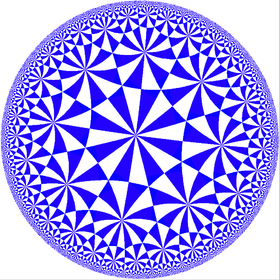Bolza surface
In mathematics, the Bolza surface, alternatively, complex algebraic Bolza curve (introduced by Oskar Bolza (1887)), is a compact Riemann surface of genus 2 with the highest possible order of the conformal automorphism group in this genus, namely GL2(3) of order 48. An affine model for the Bolza surface can be obtained as the locus of the equation
in . The Bolza surface is the smooth completion of the affine curve. Of all genus 2 hyperbolic surfaces, the Bolza surface has the highest systole. As a hyperelliptic Riemann surface, it arises as the ramified double cover of the Riemann sphere, with ramification locus at the six vertices of a regular octahedron inscribed in the sphere, as can be readily seen from the equation above.
Triangle surface

The Bolza surface is a (2,3,8) triangle surface – see Schwarz triangle. More specifically, the Fuchsian group defining the Bolza surface is a subgroup of the group generated by reflections in the sides of a hyperbolic triangle with angles . More specifically, it is a subgroup of the index-two subgroup of the group of reflections, which consists of products of an even number of reflections, which has an abstract presentation in terms of generators and relations as well as . The Fuchsian group defining the Bolza surface is also a subgroup of the (3,3,4) triangle group, which is a subgroup of index 2 in the (2,3,8) triangle group. The (2,3,8) group does not have a realisation in terms of a quaternion algebra, but the (3,3,4) group does.
Quaternion algebra
Following MacLachlan and Reid, the quaternion algebra can be taken to be the algebra over generated as an associative algebra by generators i,j and relations
with an appropriate choice of an order.
See also
References
- Bolza, Oskar (1887), "On Binary Sextics with Linear Transformations into Themselves", American Journal of Mathematics, 10 (1): 47–70, doi:10.2307/2369402, JSTOR 2369402
- Katz, M.; Sabourau, S. (2006). "An optimal systolic inequality for CAT(0) metrics in genus two". Pacific J. Math. 227 (1): 95–107. arXiv:math.DG/0501017
 . doi:10.2140/pjm.2006.227.95.
. doi:10.2140/pjm.2006.227.95. - Maclachlan, C.; Reid, A. (2003). The Arithmetic of Hyperbolic 3-Manifolds. Graduate Texts in Math. 219. New York: Springer. ISBN 0-387-98386-4.